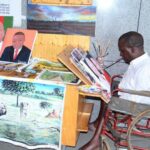5 best books by Nelson Mandela probably read by Joyce Banda
Published on December 18, 2013 at 10:47 AM by FACE OF MALAWI
In her cherished speech, President Joyce Banda in paying homage to the fallen hero that is Mandela, said that she had busied herself with reading books on Mandela and by Mandela ever since an encounter with the icon. FaceofMalawi below provides you with the 5 best books by Nelson Mandela and, we trust, President Banda has read all or some of them:
Long Walk to Freedom: The Autobiography of Nelson Mandela
This 1994 autobiography tells the story of Mandela’s life: including his early years, beginning in 1918, Transkei; his career as a lawyer and then as an African National Congress leader; a recounting of his 27 years in prison (this comprises about a third of the book); an examination of the toll being separated for so many years from his wife and children took on him; and on up to Mandela’s inauguration as president of South Africa on May 10, 1994.
The book also describes the remarkable journey Mandela made from being considered a problem by the South African government to being embraced as a great leader by the nation’s people.
Mandela’s story is stirring and some of his most-frequently-quoted words have been drawn from “Long Walk to Freedom.” Here are a few favorite passages from Mandela’s autobiography:
“I am fundamentally an optimist. Whether that comes from nature or nurture, I cannot say. Part of being optimistic is keeping one’s head pointed toward the sun, one’s feet moving forward. There were many dark moments when my faith in humanity was sorely tested, but I would not and could not give myself up to despair. That way lays defeat and death.”
“No one is born hating another person because of the color of his skin, or his background, or his religion. People must learn to hate, and if they can learn to hate, they can be taught to love, for love comes more naturally to the human heart than its opposite.” “A leader … is like a shepherd. He stays behind the flock, letting the most nimble go out ahead, whereupon the others follow, not realizing that all along they are being directed from behind.”
“For to be free is not merely to cast off one’s chains, but to live in a way that respects and enhances the freedom of others”
Conversations with Myself
“Conversations with Myself” is a personal archive that draws on letters, notebooks, taped conversations, and prison diaries to take a thorough look at all aspects of Mandela’s life. Readers will find much here that is inspiring, including lines like: “The knowledge that in your day you did your duty and lived up to the expectations of your fellow man is in itself a reward.”
Favorite African Folktales
In an effort to share traditional African folklore with as wide an audience as possible, Mandela picked out 32 folk tales, old and new, drawn from various African cultures, all rich in what Mandela calls “the gritty essence of Africa.” In terms of a contemporary African map, these stories are drawn from countries as distant as Morocco, Nigeria, Kenya, and Swaziland. They include various creation myths and tales containing morals for children and adults alike. Mandela writes in the foreword, “It is my wish that the voice of the storyteller will never die in Africa.”
Nelson Mandela: In His Own Words
This collection of speeches Mandela made throughout his life is organized by topic. Subjects include the struggle for freedom, the hard work of reconciliation and nation-building, religion, education, and culture (for example, “Music, Dance, and Poetry”). These speeches cover some of the most important moments in Mandela’s life and in South African history. Among the highlights: Mandela’s words to the Rivonia court while on trial on charges of insurrection and his commentary on South Africa’s Truth and Reconciliation Commission.
Long Walk to Freedom (adapted for children)
Mandela once wrote that, “Education is the most powerful weapon which you can use to change the world.” He was right – and that’s just one reason that teachers and parents will enjoy sharing his story with children. This edited version of Mandela’s inspiring 1994 autobiography “Long Walk to Freedom” was abridged by author Chris Van Wyck. The writing here is clear (enhanced by color-and-sepia illustrations by Paddy Bouma) and the history behind it is highly informative. The book is aimed at children ages 8 and up.


